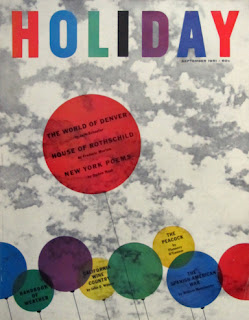O'Connor sent a photo of herself standing next to a self-portrait she'd painted with one of her peacocks to a friend in a letter dated Oct 20, 1955. She wrote, “I am the one on the left; the one on the right is the Muse."
I started reading Flannery O'Connor when I was a 15 year old high school sophomore. After Miss Marjorie E. Frye, my English teacher in Leicester, Mass., told me that I could write the Great American Novel, I set my mind on being a "famous writer." Miss Frye gave me many books to read that helped me learn the craft by seeing it practiced well, and among those books were two of O'Connor's novels and a collection of her short stories.
Just before I turned 16 I first read the really funny personal essay that eventually came to identify O'Connor as a writer about peacocks in just about everybody's mind. I saw the story when it was first published as "Living with a Peacock" in Holiday magazine in September of 1961.
The essay was also later published in the collection of O'Connor's non-fiction writings that was titled Mystery and Manners, under the title “King of Birds."
Come to think of it, "Living with a Peacock" was actually the only piece of creative writing by Flannery O'Connor that I ever really enjoyed. She was a brilliant memoirist. "Living with a Peacock" was like nothing else I've read before or since.
I didn't remotely understand her fiction until much later--after I read her own descriptions of what she was trying to do in Mystery and Manners, and even after I understood her intentions I didn't like her characters or the things they did. I admired her greatly, and I still do, even though I don't believe that she succeeded in her goal of creating in her readers' minds the grasp of spiritual realities that she sought to induce by portraying the grotesque people and violent happenings that filled her stories. For other reasons that transcended their own author's intentions, her short stories and novels endure as part of the canon of great American fiction.
 Eventually, I sought out and read everything else O'Connor ever wrote while I was working on an M.A. with writing emphasis in Minneapolis, after many unexpected relocations in my life, about fifteen years after I first was exposed to O'Connor's writing.
Eventually, I sought out and read everything else O'Connor ever wrote while I was working on an M.A. with writing emphasis in Minneapolis, after many unexpected relocations in my life, about fifteen years after I first was exposed to O'Connor's writing. Flannery O'Connor was one of the very rare women writers whose talent was undisputed by the literary establishment. I avidly read her work and I read about her partly because I wanted to find out how she had pulled it off. Another one of the reasons I returned to reading O'Connor was that I had returned to being a Catholic, so I had yet another thing in common with her. I hoped her example could show me (some way, somehow) how to succeed not only as a woman writer but as a woman writer who is a serious Catholic.
But, as I've already hinted, when I read "Living with a Peacock" in a Holiday magazine that my mother had lying around the house when I was 15, I thought it was a hoot.
What Got Her Started
In "Living with a Peacock," I learned that in 1932 Mary Flannery O'Connor got her first taste of fame at the age of five after she taught a Bantam hen to walk backwards on her family's farm in Georgia. The news of that backwards-walking-hen spread far and wide by word of mouth until somehow a British Pathé news crew found out. They came all the way to Georgia and filmed Mary Flannery and the hen, and they put the film into a newsreel that was shown round the world.
As O'Connor tells the story, the experience gave her a taste for collecting fowl and a yearning for another chance to capture the world's attention again. If she could only find a three legged chicken or some other grotesquery and get herself some more of that limelight ...
And Here's the Very Newsreel
But it wasn't until many years later that I was gratified to actually get to see the PATHÉ! news clip that she mentioned in her opening paragraphs of the Holiday article. You can view it here.
The Anguish of French Crows, Not!
Rereading 'Living with a Peacock" reminds me of one more story. When I went to France in 1997, for the first week I stayed in an ancient stone farmhouse turned guesthouse that was called Le Mas des Rives outside a village called Sauteyrargues, in Languedoc-Roussillon forty miles north of Montpelier. While I was unpacking in my upstairs room, I heard an odd type of cawing coming through the windows from the shrubbery around the farmyard. It could be a crow, I thought, maybe, but if so, French crows must have far more angst than their American cousins.
When the group I was with was eating together later outside at a picnic table, I saw that what I had first thought was an anguished crow's croak was actually coming from the throat of a peacock dragging its long feathered tail across the lawn.
Finally, I'd gotten to share one part of Flannery's life experience. I had seen and heard a peacock in a farmyard, even though it was a guest house in Languedoc-Roussillon and not a working farm in Georgia.





No comments:
Post a Comment